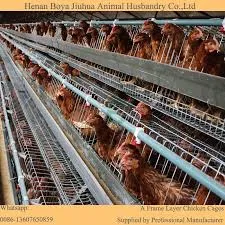High-Quality Poultry Egg Layer Cages for Optimal Egg Production
ਸਤੰ. . 01, 2024 03:42 Back to list
High-Quality Poultry Egg Layer Cages for Optimal Egg Production
The Importance of Poultry Egg Layer Cages in Modern Farming
In the contemporary landscape of agriculture, poultry farming has carved out a significant niche, particularly in the production of eggs. Among the various components that contribute to the efficiency and effectiveness of egg production, poultry egg layer cages stand out as a crucial element. These cages are designed to enhance the living conditions of hens while maximizing egg output.
Poultry egg layer cages serve multiple purposes. Primarily, they provide a safe and comfortable environment for hens, protecting them from predators and harsh weather conditions. The design of these cages allows for proper ventilation and minimal stress among the birds, which is essential for their overall health and productivity. When hens are kept in a stress-free environment, they are more likely to produce a higher number of quality eggs.
Moreover, layer cages maximize space utility in poultry farms. By allowing farmers to house a larger number of hens in a compact area without compromising their welfare, these cages increase overall production efficiency. This vertical farming approach not only conserves land but also makes it easier for farmers to manage their flocks, providing better monitoring of health and egg production rates.
poultry egg layer cages

Another noteworthy advantage of using layer cages is the improvement in egg hygiene. Traditional farming methods often expose eggs to contaminants found in the environment. However, with cages, eggs are laid directly onto clean collection surfaces, minimizing the risk of fecal contamination and ensuring the eggs are in optimal conditions for sale and consumption.
Furthermore, layer cages support automation in egg production. Modern poultry farms are increasingly adopting automated systems for feeding, watering, and egg collection. This mechanization reduces labor costs and enables farmers to focus on other critical areas, such as flock health and biosecurity.
However, it is essential to address animal welfare concerns associated with cage systems. The industry has seen a shift towards enriched cages that provide hens with more space and opportunities for natural behaviors. This evolution reflects growing consumer awareness and demand for humane farming practices.
In conclusion, poultry egg layer cages are paramount in modern poultry farming. They enhance production efficiency, ensure hygiene, and contribute to the overall health of hens. As the industry moves forward, continuing to balance productivity with animal welfare will be vital in meeting both economic and ethical standards.
-
Automatic Feeding Line System - Anping Yize | Efficiency&Durability
NewsJul.29,2025
-
Automatic Feeding Line System - Anping Yize|Poultry Efficiency&Durability
NewsJul.29,2025
-
Automatic Feeding Line System-Anping County Yize Metal Products Co., Ltd.|Durable PP Material&Easy Maintenance
NewsJul.29,2025
-
Automatic Feeding Line System-Pan Feeder Nipple Drinker|Anping County Yize Metal Products Co., Ltd.
NewsJul.29,2025
-
Hot Sale 24 & 18 Door Rabbit Cages - Premium Breeding Solutions
NewsJul.25,2025
-
Automatic Feeding Line System Pan Feeder Nipple Drinker - Anping County Yize Metal Products Co., Ltd.
NewsJul.21,2025






